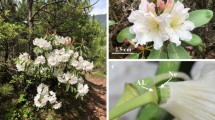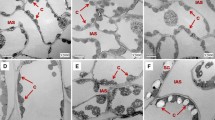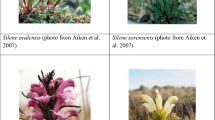Summary
Measurements and modeling of photosynthesis, respiration and growth in flowers of Diplacus aurantiacus, a semidrought-deciduous shrub, indicate that they can provide 18%–25% of their total carbon requirements through photosynthesis of flower parts. Daily photosynthetic carbon fixation exceeds daily respiratory CO2 loss during most non-fruiting stages of development. However, this carbon gain fails to meet the requirements for new biomass construction during bud growth and corolla expansion. During fruiting stages, insufficient carbon is fixed to fully supply either respiration or growth.
The calyx performs most of the flower's photosynthesis throughout the life of the flower. However, during stages of fruit development, the contribution of the ovary to flower photosynthesis may equal that of the calyx.
Similar content being viewed by others
References
Alpert P, Newell E, Chu C, Glyphis J, Gulmon S, Hollinger DY, Johnson N, Mooney HA, Puttick G (1985) Allocation to reproduction in the chaparral shrub, Diplacus aurantiacus. (in preperation)
Bazzaz FA, Carlson RW (1979a) Photosynthetic contribution of flowers and seeds to reproductive effort of an annual colonizer. New Phytol 82:223–232
Bazzaz FA, Carlson RW, Harper JL (1979b) Contribution to reproductive effort by photosynthesis of flowers and fruits. Nature 279:554–555
Benedict FG, Oshorne TB (1907) The heat of combustion of vegetable proteins. J Biol Chem 3:119–133
Biscoe PV, Gallagher JN, Littleton EJ, Monteith JL, Scott RK (1975) Barley and its environment. IV. Sources of assimilate for the grain. J Appl Ecol 12:295–318
Flinn AM, Pate JS (1970) A quantitative study of carbon transfer from pod and subtending leaf to ripening seeds of the field pea (Pisum arvense L). J Exper Bot 21:71–82
Gadgil M, Solbrig OT (1972) The concept of r- and K-selection: Evidence from wild flowers and some theoretical considerations. Am Nat 106:14–31
Gnaiger E, Bitterlich G (1984) Proximate biochemical composition and caloric content calculated from elemental CHN analysis: a stoichiometric concept. Oecologia (Berlin) 62:289–298
Harper JL, Ogden J (1970) The reproductive strategy of higher plants. I. The concept of strategy with special reference to Senecio vulgaris L. J Ecol 58:681–698
Lincoln DE (1980) Leaf resin flavenoids of Diplacus aurantiacus. Biochem Syst Ecol 8:397–400
McDermitt DK, Loomis RS (1981) Elemental composition of biomass and its relation to energy content, growth efficiency and growth yield. Ann Bot 48:275–290
Merino J, Field C, Mooney HA (1982) Construction and maintenance costs of mediterranean-climate evergreen and deciduous leaves I. Growth and CO2 exchange analysis. Oecologia (Berlin) 53:208–213
Merino J, Field C, Mooney HA (1984) Construction and maintenance costs of mediterranean-climate evergreen and deciduous leaves II. Biochemical pathway analysis. Oecologia Plant 5:211–229
Palomino M (1974) A comparative study of the time and energy budgets for breeding Anna's and Allen's hummingbirds. (unpublished manuscript)
Penning de Vries FWT (1972) Respiration and growth. In: AR Rees, KE Cockshull, DW Hand, RG Hurd (eds) Crop processes in controlled environments. Academic Press, London, p 327–347
Penning de Vries FWT, AHM Brunsting, HH van Laar (1974) Products, requirements and efficiency of biosynthesis: a quantitative approach. J Theor Biol 45:339–377
Penning de Vries FWT (1975) The cost of maintenance processes in plant cells. Ann Bot 39:77–92
Ruckelshaus M (1982) Variables affecting nectar secretion and concentration in Diplacus aurantiacus. Senior honors thesis, Department of Biology, Stanford University
Weast RC (ed) (1979) CRC Handbook of chemistry and physics, 60th ed. CRC Press, Boca Raton, Florida
Werk KS, Ehleringer JR (1983) Photosynthesis by flowers in Encelia farinosa and Encelia californica (Asteraceae). Oecologia (Berlin) 57:311–315
Winner WE, Mooney HA (1980) Ecology of SO2 resistance: I. Effects of fumigations on gas exchange of deciduous and evergreen shrubs. Oecologia (Berlin) 44:290–295
Author information
Authors and Affiliations
Rights and permissions
About this article
Cite this article
Williams, K., Koch, G.W. & Mooney, H.A. The carbon balance of flowers of Diplacus aurantiacus (Scrophulariaceae). Oecologia 66, 530–535 (1985). https://doi.org/10.1007/BF00379345
Received:
Issue Date:
DOI: https://doi.org/10.1007/BF00379345




